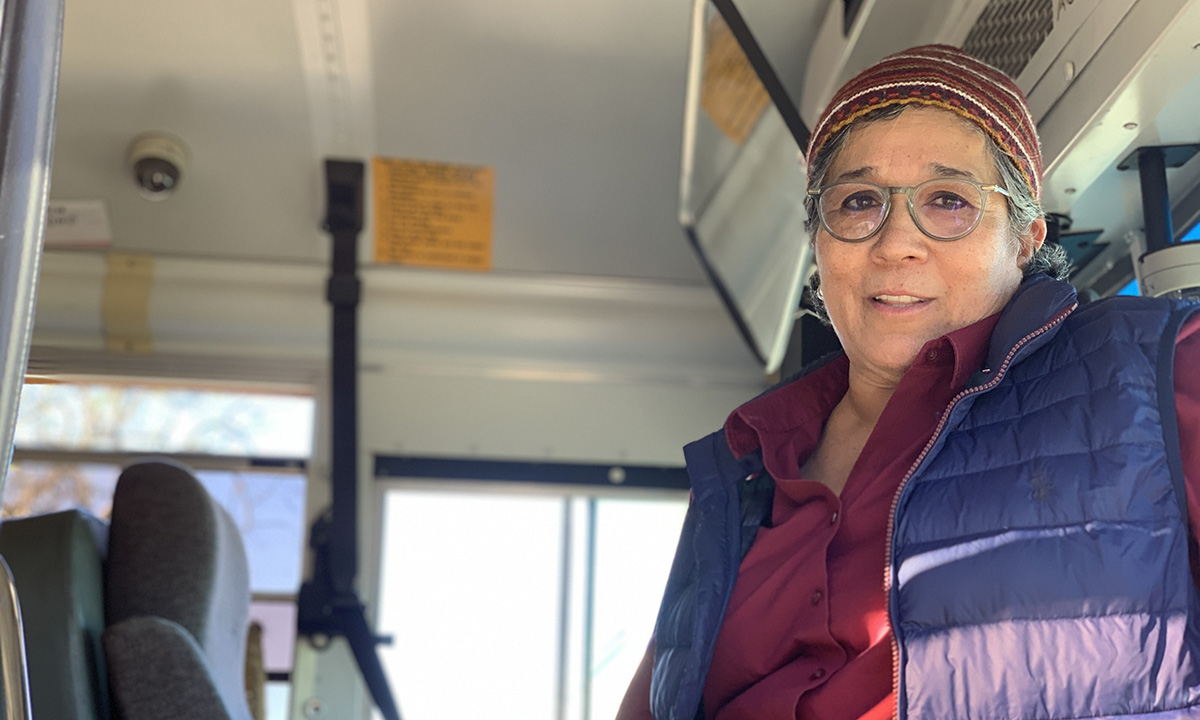Uvalde Hero: Amid the Chaos at Robb Elementary, the Bus Driver Who Saved Lives
Sylvia Uriegas says she and other bus drivers were never trained for the vital, life-saving role they played responding to the mass school shooting.

Get stories like this delivered straight to your inbox. Sign up for The 74 Newsletter
When Uvalde school bus driver Sylvia Uriegas got the call on May 24 to report to Robb Elementary, she had no idea about the horror she was approaching.
With nothing but a rudimentary first aid kit filled mostly with Band Aids, Uriegas had been called to the scene of one of the nation’s worst mass school shootings — with no training for the important role she would play as the chaotic scene unfolded.
When Uriegas and two other bus drivers, who were taking kids to a field trip at a nearby park, reached the school, the streets were swarmed with law enforcement and parents. The central office dispatcher who asked her to report to the school had warned of an “emergency” — but said no more.
With her normal path to the building blocked, Uriegas backed her bus up and found another route. The two other school buses followed. Another driver opened her door and asked a bystander what was happening. Only then did they learn that there was an active shooter inside Robb.
Ultimately, Uriegas’ bus became a makeshift ambulance that carried kids with gunshot wounds to the hospital.
“We’re not first responders,” Uriegas said. “But then we were.”
Her experience echoes many of the stories from Uvalde on that day. Chaos, unclear chains of command and confusion about protocol prevented an effective response that could have saved at least a few of the 19 children and two teachers slain by the lone gunman. Police waited 77 minutes after the shooter entered the school before they stormed the classroom where he was holed up with dying children and teachers.
Once the classroom was breached, officials lacked the resources and coordination needed to provide the proper medical response.
Though Uriegas did save lives, it made her aware of a glaring hole in the district’s school safety plan.
“I could have gone in knowing a little bit better,” Uriegas said. “But we’ve never been trained.”
Other than speaking at school board meetings asking for better training, she kept her thoughts and feelings to herself, knowing what she saw and experienced could not compare to the parents who had lost children, and the survivors themselves.
But when she ran into some of the family members of slain 9-year-old Jackie Cazares, they urged her to tell the story from the driver’s seat — the full scope of all that had gone wrong, of the mishandling and lack of preparedness needed to be made public, they said.
As the passage of time and the levity of the holidays pushes the tragedy from the headlines, Uriegas and the families don’t want complacency to set in, for Uvalde to forget just how unprepared it had been.
So Uriegas has decided to tell her story.
When the buses reached Robb, no one on the outside knew the status of the situation inside, and parents were frantic during the nightmarish hour they waited for law enforcement to take control.
But for Uriegas, the nightmare began once the shooting was over and children began evacuating. “Once I saw the kids that changed everything.”
Lines of sobbing children headed for the other buses to be taken to a reunification center, but law enforcement approached Uriegas’s bus with a wounded student and told her more were on the way. The officer asked if she had any medical supplies, and Uriegas scoffed at the memory of handing over what she called her “Mickey Mouse” first aid kit with little more than Band Aids inside.
Outside on the sidewalk another officer was performing CPR on a child. Parents had picked up on the evacuation and began searching for their children. Some were pounding on the windows of Uriegas’ bus, begging to know if their kids were inside. “They wanted to see which kids were in there, which is natural,” she said.
Uriegas realized it was only a matter of time before a parent tried to breach the bus’s emergency exit, in the back where the officers were doing their best to administer first aid to a boy who had been shot through the thigh. She could see the potential for more damage if panicked, frantic people rushed onto the bus, so she locked the emergency exit, which went against her training. But then, she realized, nothing in her training seemed to apply to this situation. She only had her instincts.
She’s lucky that her instincts were to stay calm, said international transportation safety instructor Bret Brooks, whose company, Gray Ram Tactical has provided school bus drivers all over the United States, including many in Texas, emergency training. “Our subconscious will take over in an emergency.”
“Drivers need a different training than teachers. Your response inside of a school building is drastically different than the response on a moving vehicle moving down the highway,” Brooks said. The bus should also be equipped with more than bandaids, he added. At the very least a bus should have a tourniquet, chest seal, and Quikclot gauze.
Bus drivers’ role as first responder is evolving. Since 2015, Gray Ram has been tracking data showing an increasing number of firearms used in school shootings arriving at school by bus.
If the drivers are trained to identify the behavior of someone carrying a gun or intent on violence, they can notify the school to be ready. “One of the things unfortunately that we find is that a lot of administrators don’t consider the bus drivers and the buses as critical to the education system,” Brooks said.
That’s what Uriegas experienced, she said, a sense of being unprepared and then forgotten, even though she played a critical role on the day of the tragedy. Of the kids she took to the hospital, she knew two of the boys by name, but not a third, a little girl, whose face she cannot remember, but whose screams she will never forget. She drove the students and officers to the hospital, praying along the way.
After the hospital, Uriegas dropped off the bus at the district depot. It’s usually the drivers’ job to clean their own buses, but when the crew saw the blood all over the inside, they told her to stand down, they would handle it. She was grateful, but not ready to call it a day. She took another bus and returned to Robb, just in case.
She heard later the students she transported all survived. She’s grateful for that. It gives her some comfort as she struggles to make sense of that day.
Neither she nor the bus drivers who made multiple evacuation rounds delivering traumatized students to the reunification center were part of any counseling or outreach effort from the district. A spokesperson for the district did not respond to The 74’s request for comment.
Uriegas sought her own counseling through the Children’s Bereavement Center, which also offers counseling for adults, but she said the depression has been hard to fight, especially with the holidays. “I am definitely more sensitive and everything makes me tear up,” she said.
The memories are always with her in some ways, but specific moments of terror come back without warning, she said. At a Thanksgiving family gathering, the happy shouting and squealing of children put her back on the school bus with the screams of wounded children.
She noted that even a memory of her parents waking her and her siblings up to a vinyl record of Feliz Navidad on Christmas morning immediately sent her mind to the families and teachers of Robb. “This,” said Uriegas, “will be a sad Christmas for them.”
Get stories like these delivered straight to your inbox. Sign up for The 74 Newsletter

;)
